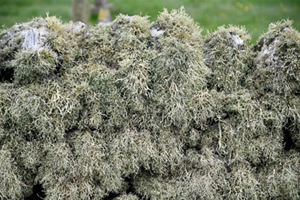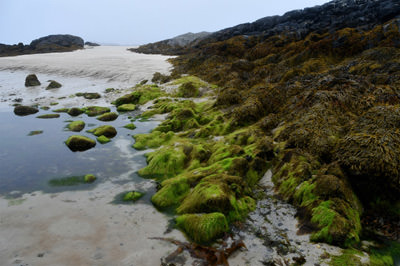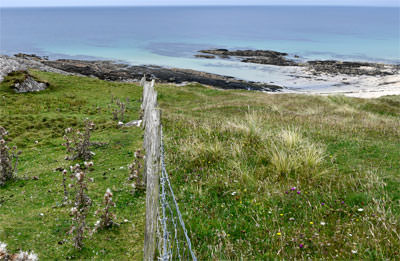Just a hundred miles north-west of Glasgow, where the COP26 conference is being held in November, lies the Inner Hebridean Isle of Coll. With its adjacent sibling Isle of Tiree, it feels less an off-cut of mainland Scotland than a vagrant from the Outer Hebrides, blown in toward the shore. Two and a half hours by ferry from Oban, it faces inland but has its back to an open Atlantic that runs two and a half thousand miles clear to America. Apartness yet being grounded against distance runs deep on Coll.
On the island’s exposed north-west coast, tucked behind tall sand dunes, is Toraston cemetery, marked on the OS map as a burial ground. There is a second and much smaller cemetery at Crossapol on the island’s south-west tip, but Toraston serves as resting place for Collachs from across the island - and for often unnamed seafarers washed ashore. A rustic stone wall bisects the cemetery, one half of it clearly older than the other and showing a cavity where a kirk once stood. As your eyes settle on the wall, your mind registers the scene with astonishment: it has been overwhelmed by a dense growth of grey-green lichen whose branches are in places six inches long. Several headstones also wear the same protective cloak, wrapped around the sides and tops, natural mantles shielding the stones against the elements. Perhaps relatives clip back this luxuriant growth to leave inscriptions visible. On others, the lichen gains no purchase on a headstone’s surface but fluoresces from the inscription’s individual letters. It is as if nature refuses to abandon the souls buried there. Each of these is presence as well as headstone.
Humdrum fenceposts are not immune to this accompaniment, here a junior upstart, although no less ethereal:
In Crossapol Cemetery other lichens appear in squat blotches on headstones tilted in the shifting ground. A solitary obelisk gathers the stuff as if calling it down from the huge skies. Winds, even in this exposed place, fail to scour the stone’s surface clean.
As on the Outer Hebrides, Coll has few trees, a legacy variably of the Vikings, of ancient climate change or of grazing sheep, depending on whom you talk to - or read, although the consensus settles on the likelihood that millennia ago it was peat that became the dominant habitat, making widespread forestation impossible. (See footnote on trees.) Those trees that manage to withstand the wind’s brunt do so in the lee of sand dunes, in hollows or inside ruined crofts … whose roofs would have been supported by timber imported from the mainland or from Scandinavia - or even gleaned from flotsam and jetsam. Indeed, one story tells of a croft using a remodelled stern board as its main roof timber.
Coll’s present-day population appears in conflicting totals: 220 or 185, maybe 160 or 150. The 1841 census records a population of 1,414 after which time evictions of farming families began to take their toll. It is hard to imagine Coll at 13 miles by 3 supporting such a population for long.
Arinagour, near where the CalMac ferry makes its daily stop, is the island’s ‘largest’ settlement, although you can walk its couple of roads and lanes in under half an hour. It is also home to the island’s An Cridhe community centre (with seating for upto 269, a number significantly in excess of the island’s resident population) and adjacent Bunkhouse which provides hostel-style accommodation. Both of these were opened by Princess Anne in 2012. They are substantial investments, owned and run by Development Coll to promote sustainable development and regeneration on the island. All of this is impressive. Judging by the carving on the community centre’s reception desk, these efforts have real purpose and affection. From left to right, there is a heron in front of the Project Trust centre on the island’s north-west coast, long-horn cattle, sheep, the traditional blackhouse dwelling that served as shelter before the onset of modernity, the stone-encased postbox from the north of the island - on which stands a lapwing, reeds, a bumblebee, machair, orchids, geese, the burial ground at Crossapol, and the elusive corncrake - all are represented. Below it, the silhouette of neighbouring islands frames the scene. It is a thing of great beauty.
Further community integration is provided by the The Coll Association which brings together generations of Collachs and friends of the island. (They have glorious photographs, old and new, on their website.) A separate Homecoming Coll 2018 venture looks to have been very active, serving to remind us that during more challenging times many Collachs emigrated to distant parts of the English-speaking world. Many Collachs also have one further historic link: to clan MacLean (of Coll).
These inbound links are mirrored by the outbound ones created through Project Trust, the island’s largest employer. An educational gap year charity, the Trust has had its base on Coll since 1947. Each year it sends around 300 school-leavers to far-flung corners of the globe as volunteers. Their preparation for this formative experience takes place at the Trust’s Hebridean Centre on Coll’s west coast. All these and more are the groundings against distance that run deep on Coll
Coll’s population therefore ebbs and flows, both over time and across the seasons. Residents are used to the slower presence of visitors and tourists on the island’s single-track roads. Dunbar’s number is a proposed mental limit to the number of folk with whom one can maintain a stable social relationship, 150 according to the eponymous anthropologist. Is this a key to understanding the consistent friendliness of Coll’s residents?
Caledonophiles know that the best beaches in the world are found on the west coast of Scotland and in the Hebrides. Their curving whiteness, framed by machair-clothed dunes and ancient rock, sets them apart from anything more exotic. That they are not thronged by the madding crowd cements that hyperbolic ranking. Coll and Tiree on their own justify these claims, and you will never be disappointed.
‘You takes your chances’, as the saying has it, and the sun’s brief appearance (caught in the photograph above), which turns the water turquoise, may be a rare thing on any visit, so be prepared for greyer skies which have their own special attraction.
Breachacha, Crossapol, Feall, Hogh, Cliad, Toraston (Trailleich) and Sorisdale are all names to roll around the tongue, bays to savour, beaches to tramp the length of, explore, paddle on and picnic beside. Countless smaller ones tuck themselves into coastal crevices. One of the greatest thrills that Coll offers is to identify which, if any, will be your favourite. And as that quest unfolds, you will traverse a landscape of unusual richness and exquisite beauty right under your very feet.
Machair fringes Coll’s western beaches and carpets the dips between its dramatic sand dunes. Pronounced makker, according to some, it is a habitat unique to Scotland’s western coast and the western isles and is found only on its Atlantic-facing edges. It is a rare and special habitat, formed over millennia from shell sand and low-intensity grazing, enabling a dense carpet of low grasses and wild flowers to flourish. Stoop down to it, focus and engage with it and the profusion and variety becomes a thing of wonder; step sideways ten paces and the numbers start to climb. In six days of walking, our amateur eyes spotted sixty species of wild flowers, dwarf huddlers keeping themselves out of the wind. Yarrow and wild carrot, two metres tall in southern England, top all of five inches; self-heal and red clover tuck themselves just above ground level; lady’s bedstraw neighbours rosebay willowherb and common eyebright; harebells tremble in the breeze; unsought scarlet pimpernel prostrates itself. Yellows shimmer alongside pinks, blues and whites.
In Sea Room, Adam Nicholson captured machair perfectly. Away from the Shiant Isles (that his father gave him on his twenty-first birthday, and which he gave his own son when he too reached twenty-one) he wrote, “I think of it when in England I walk on expensive Persian rugs; the same points of dense, discreet colour … a sudden flash of the Hebrides in a rich man’s rooms. It is a private signal to me, a bleeping underfoot”. And rightly so. Machair is priceless, amounting to an incalculable natural wealth, in itself a bed fit for paradise. Machair is justification on its own for northbound pilgrimage.
Coll is a jewel, a gem, a place that once visited will long occupy your thoughts. It will linger like a curlew’s call, half-heard, half-imagined, elevating the unfocussed mind onto a simpler, less cluttered plane.
Links
An Cridhe: Coll’s community centre, the island’s heart
Basking Shark Scotland: low-impact tours looking for these gentle giants
Coll Digital: photography, prints, calendars and web design from Coll
Development Coll: promotes sustainable development and regeneration on Coll
Homecoming Coll 2018: a week of activities, archived
IsleGo: sea taxi trips with Collach John Fraser
Ise of Coll Genealogy: statistics down the ages
Project Trust: home of the gap year charity
RSPB: which birds, when and where on Coll
The Coll Association: bringing together generations of Collachs and friends of the island
The Coll Bunkhouse: hostel accommodation on Coll
The Coll Hotel: the island’s hotel run by the Oliphant family since the 1960s, and recently extend. The hotel offers comfort and sustenance to residents and is home to the island’s only bar. It is a perfect place from which to explore this very special Hebridean gem and we can highly recommend it.
Toraz car hire: rent a car on tiny Coll
Wildsmiths: guided wildlife walks on Coll
Visit Coll: extolling Coll’s delights
A note on spelling
Toraston burial ground has been referred to here with its final vowel being ‘o’ because the gate beside it names the adjacent farmland as being spelt that way. On the OS Explorer map 372 for Coll and Tiree, the farm some half a kilometre inland from the burial ground uses the same name but with the final vowel being ‘a’.
Footnote on trees
A fascinating article in The Guardian on 31st August 2024, Profits from community windfarm to fund a million native trees in Hebrides, attributes tree loss on Lewis in the Outer Hebrides to deer, and to sheep and cattle sent on to common grazings during the summer. The applicability of this to Coll may very but the underlying account is worth a read. The planting of trees by the community on Lewis, funded by an onshore windfarm, deserves attention in itself.















